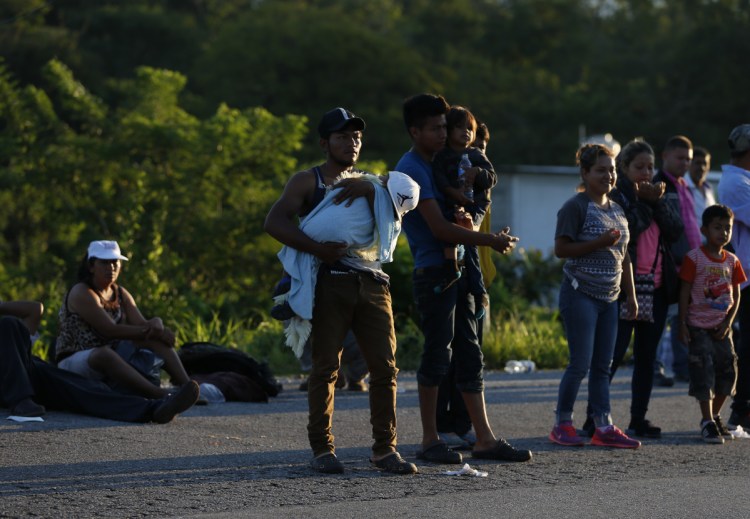WASHINGTON — The Trump administration is planning to dispatch at least 800 active duty troops to the southern border at the direction of a president who has sought to transform fears about immigration into electoral gains in the midterms as a caravan of thousands of migrants makes its way through Mexico.
Defense Secretary Jim Mattis is expected to sign an order sending the troops to the border, bolstering National Guard forces already there, an official said Thursday. The action comes as President Trump has spent recent days calling attention to the caravan of Central Americans slowly making their way by foot into southern Mexico, but still more than 1,000 miles from U.S. soil.
Trump, who made fear about immigrants a major theme of his 2016 election campaign, has been eager to make it a top issue heading into the Nov. 6 midterm elections, which will determine control of Congress. The president and senior White House officials have long believed the issue is key to turning out his base of supporters.
The additional troops would provide logistical and other support to the Border Patrol, said the U.S. official, who spoke on condition of anonymity to discuss a plan that had not been finalized and formally announced.
It’s not unusual for the National Guard to help with border security. Active duty troops, however, are rarely deployed within the United States except for domestic emergencies like hurricanes or floods. Fears of militarizing the border were fanned by a May 1997 incident in which a Marine on a counter-narcotics mission shot to death an 18-year-old who was herding goats in Redford, Texas.
Troops being sent at Trump’s direction would not be on armed security missions. They would assist the Border Patrol by providing things such as vehicles, tents and equipment. There already are about 2,000 National Guard members there under a previous Pentagon arrangement.
Trump has used the caravan to bolster his election-season warnings that the U.S. is being infiltrated by illegal immigrants “pouring across the border,” whom he has painted with a sinister brush.
He has claimed, without any apparent basis in fact, that “Middle Easterners” were among the group. At rallies and on Twitter, Trump has tried to portray the Democrats as pro-illegal immigration, even claiming, with no evidence, that Democrats organized the caravan.
He tweeted Thursday that, “Democrat inspired laws make it tough for us to stop people at the border” and said he was using the military to respond to what he called a “National Emergency.”
The migrants in the sprawling caravan — once estimated by the United Nations to number more than 7,000 — are hoping to make it to the United States. Most are Hondurans, seeking to escape poverty and violence, and include families with children.
The caravan swelled dramatically soon after crossing the Mexican border on Oct. 19, but sickness, fear and police harassment have whittled down its numbers.
Trump tweeted a direct message to the migrants Thursday, urging them to return home.
“To those in the Caravan, turnaround,” he wrote. “We are not letting people into the United States illegally. Go back to your Country and if you want, apply for citizenship like millions of others are doing!”
The migrants have largely been disconnected from news reports about them. When asked about Trump’s tweets, they have generally responded that he should stop attacking them and said they would keep heading north.
Candy Guillermo, a 37-year-old migrant in the caravan who had heard about the plan to deploy troops, was surprised she and the children in group would be considered a threat. “Trump should be more humanitarian,” she said. “We only want to give our kids a better future.”
Migrants who do reach the U.S. border can claim asylum under U.S. and international law. Those who clear an initial screening are often released until their cases are decided in immigration court, which can take several years.
The U.S. had 331,700 asylum claims in 2017, more than any country in the world, according to the U.N. Refugee Agency. That’s nearly double the asylum claims the U.S. fielded in 2015 and nearly quadruple the claims in 2013.
Trump ordered the deployment of the National Guard earlier this year to respond to a spike in illegal crossings. Those troops are under the control of state governors and are limited to support roles such as providing surveillance.
The planned deployment of active duty troops is in response to a request from the Department of Homeland Security, which manages the Border Patrol, a U.S. official said.
DHS asked for help in various forms, the official said, including air transport and other logistical assistance. It was not immediately clear why active duty forces were sought because National Guard troops can perform the same functions. Earlier this year Mattis authorized Pentagon funding for up to 4,000 National Guard troops on the border and thus far only a little over 2,000 have been used.
Federal law prohibits the use of active duty service members for law enforcement inside the U.S. unless specifically authorized by Congress.
Trump seemed to hint at the troop announcement to a rally in Wisconsin on Wednesday. “Wait’ll you see what happens over the next couple of weeks. You’re going to see a very secure border,” he said. “You just watch.”
Send questions/comments to the editors.



Success. Please wait for the page to reload. If the page does not reload within 5 seconds, please refresh the page.
Enter your email and password to access comments.
Hi, to comment on stories you must . This profile is in addition to your subscription and website login.
Already have a commenting profile? .
Invalid username/password.
Please check your email to confirm and complete your registration.
Only subscribers are eligible to post comments. Please subscribe or login first for digital access. Here’s why.
Use the form below to reset your password. When you've submitted your account email, we will send an email with a reset code.